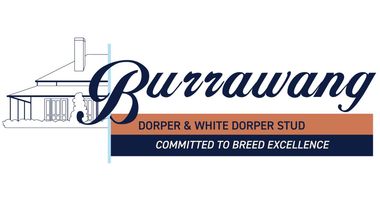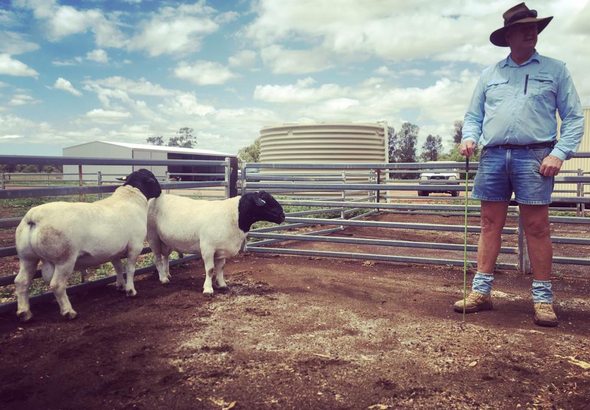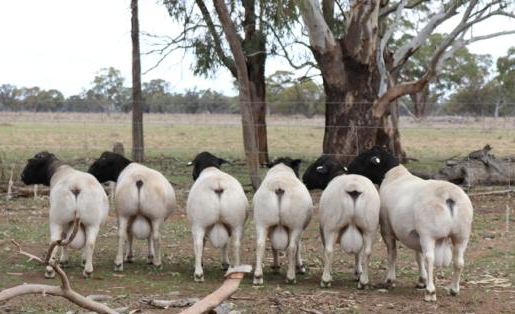About Us
The Stud

Dorpers first arrived in Australia in 1997 and moved into NSW by 1999. Few people across the country were involved in stud breeding during those early days with most of the stock made available through genetic imports. Despite the wide variety in the animals born from the genetics imported from South Africa, demand grew strongly due to the breed’s adaptability.
As we considered establishing our enterprise based on dorpers, we recognised that the breed has the potential to improve the productivity of livestock operations throughout western NSW significantly, Victoria and Queensland but that the breed would not survive long term if structural problems, inherent in the available and sold animals at that time, were not addressed.
We began the process of establishing and developing a stud flock, determined to breed animals that:- are reliably sound- are free moving- are mobile enough to cover large dry areas- offer all of the benefits of Dorpers as a self-replacing, maternal flock, meat sheep, and that can also perform well for terminal flock use.
We are total devotees, with no apologies for our commitment to the South African Dorper Society Breed Standard. This commitment is based on our appreciation that Dorper is the fastest-growing meat sheep breed in the world because the very clever founders of the breed set the standard and established a great educational system to support the breed's progress.
We committed to disregarding the short term financial implications of culling inferior animals in our quest to eradicate any structural weakness in our animals as quickly as possible. No matter how frustrating or costly it may be, we've never hesitated to cull animals that do not meet breed standards.
By early 2016, our Dorper and White Dorper stud included 1000 breeding ewes. The stud flock has been built with quality foremost in mind. We’ve set very high standards for the ewes that are retained and used in the stud.
We’ve become passionate about breeding high-quality Dorpers because we understand the contribution this breed can make to Australia’s meat sheep industry's success if the breed standards are respected and maintained.
We find it satisfying to introduce other farmers to the Dorper breed through our work in the stud and our training programs, so more people choose dorpers to build or improve their own grazing enterprises.
Converting to Dorpers

"With our decision to convert the relatively dormant Burrawang West Station into a sustainable livestock operation, we expected and welcomed a steep learning curve. The lessons came quickly, beginning with a decision to take full advantage of the property’s potential productivity and water rights by installing a centre pivot in early 2001.
We hadn’t foreseen, nor were we in any way prepared for, an extended drought.
It came on suddenly. As if someone turned the tap off. 2002.
You have to have water to run a pivot, and there was no water to be had. The pivot was nothing more than an oversized coat hanger sitting like found object art in the paddock” Graham recalls.
Without cropped and stored feed, finishing cattle became a real challenge. Calving was a nightmare. By mid-2002, all of the livestock was on agistment, 6 ½ hours northeast of the station.
Enter Uncle Edgar; 87 years wise and full of willing and worthwhile advice. With 55 years of farming in Australia under his belt, he turned to Graham one memorable evening. “My boy” Edgar began, “remember Australia is the driest continent on earth. It occasionally has good seasons. Run your farm accordingly.”
Over the years since that night, we thank Uncle Edgar for his sage advice and consider ourselves lucky that we chose to take it. This was the real starting point for our journey to find a suitable way to create a sustainable agricultural business on Burrawang.
Though our station is perfectly suited to cropping, we were more interested in livestock as our primary endeavour. The challenge was to find a breed of livestock that is well suited to thrive in conditions such as Burrawang’s.
After much research and careful consideration, we discovered that Dorpers seemed to be doing very well in the Karoo in South Africa where average rainfall is 10 inches. Given our average annual rainfall is around 17, we felt Dorpers could be “a natural fit”.
We began serious research, evaluation and planning in late 2002. In 2003, we bought our first White Dorpers and started building a pure-blood commercial flock.
The more we learned, worked with and understood the breed, the more convinced we become that Dorpers are the ideal sheep breed for our area and similar areas across the country. The economics of running Dorpers provides compelling support for our decision.
We’re not looking for affirmation but find it at every turn.


